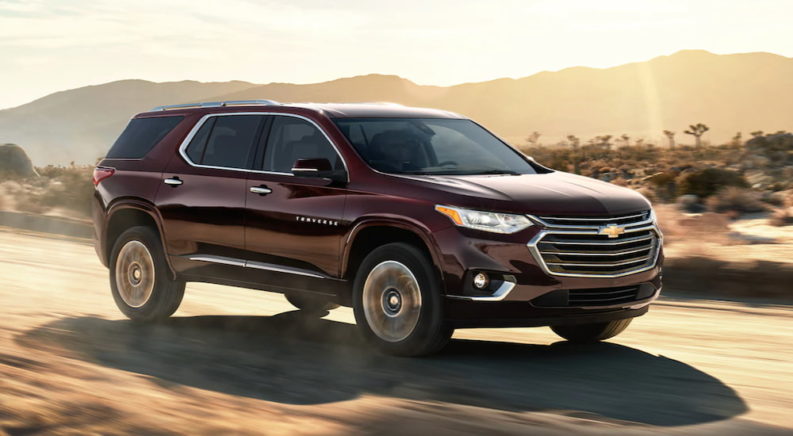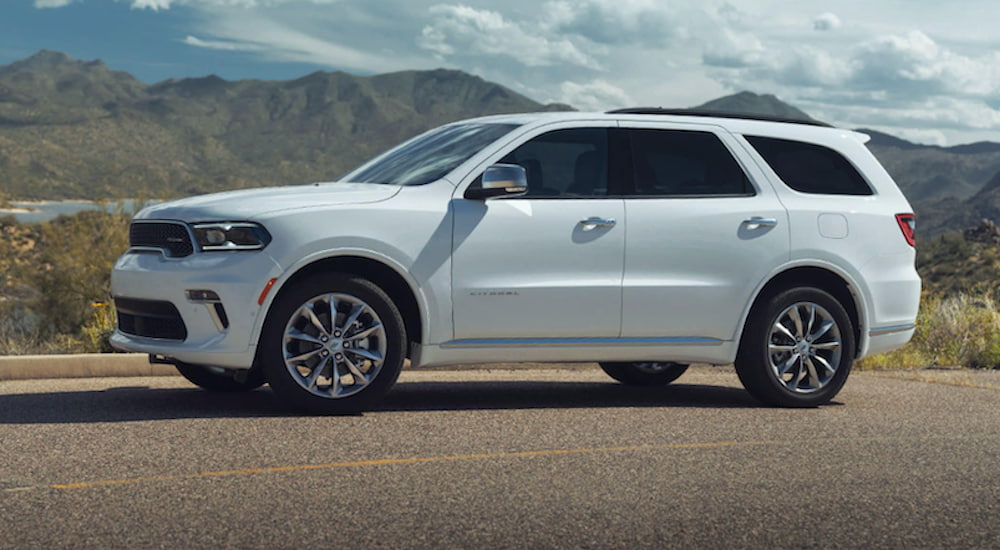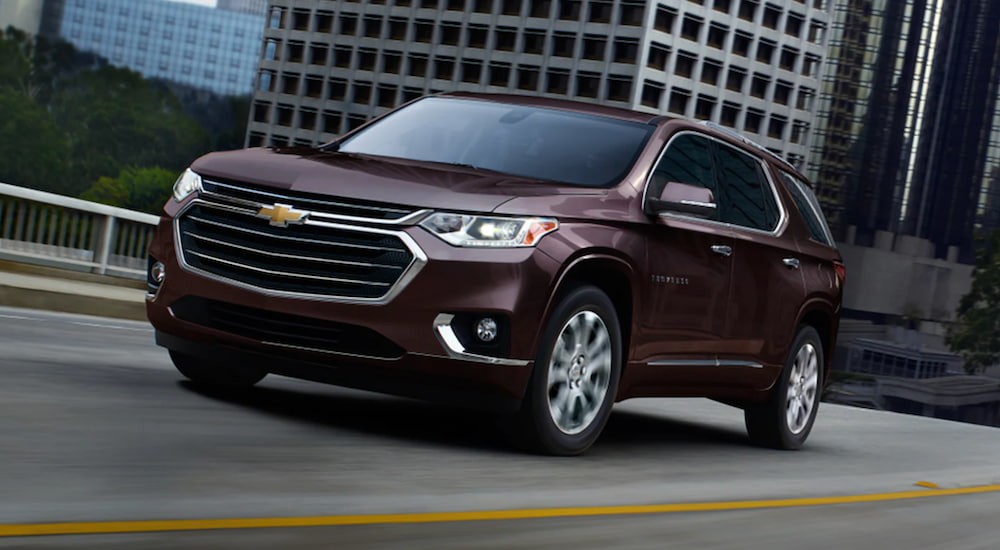Midsize SUVs are hardly the most beloved body styles in the auto market. Less flashy than small sports cars, less contemporary than sedans and compact SUVs, and less ultra-potent than pickup trucks, midsize SUVs spend most of their marketing campaigns trying to get away from the soccer mom aesthetic. Compare the 2021 Chevy Traverse vs the 2021 Dodge Durango, and you get far more from each SUV than boring family dynamics.
Rather, the Traverse and Durango have surprising features that just may make the midsize three-row SUV competitive again. While both vehicles are all-around excellent and could share the top spot, what fun is there in that? Let’s break down these two big guys and see which of the two more successfully breaks from their body style’s dull reputation. Start by taking a look at what exactly the Traverse is and who it’s aimed at.
The Traverse: Overview
The Traverse is an oddity to some. It’s not the first or second but the third three-row SUV offered by Chevy. It may seem like an unnecessary addition to the Chevy lineup, given the popularity of the Suburban and the Tahoe, with the Suburban being the family staple vehicle and the Tahoe being the slightly more compact, more driveable version of the two. So, where does the Traverse fit into this lineup as Chevy’s middle child?
The Traverse is actually the most affordable, most family-friendly SUV in the Chevy lineup, exuding comfort, classic Chevy sophistication, and even good fuel economy. This is a surprising feature you may not expect of such a large vehicle. From its spacious interior to its affordable high-end trims that spruce up the Traverse’s tech and safety offerings, this may be the best midsize SUV for the money.
The Durango: Overview
What a strange sight this beast is. Resembling less of an SUV and more of a blown-up muscle car, the Durango is clearly Dodge’s attempt to reinvent the midsize SUV. Forget soccer mom aesthetics; with sharp headlamps, a dominant front grille, a rear spoiler, and a muscled front hood, the Durango says “moms beware.”
This three-row SUV has made waves thanks to its outstanding engine offerings. While many of its competitors start with a 4-cylinder engine, the Durango’s base model is powered by a capable V-6, with sky’s-the-limit engines well beyond other competitors of the same body style. Weirdly enough, the Durango is also a significant tower, with a shocking 8700-pound capacity and “Tow N Go” package that offers all the right towing equipment. Clearly, what it does, it does well. However, in its focus on ultimate SUV power, there may be some oversights.
Where the Durango Stands Out: Performance
Now let’s pit the two against each other. The 2021 Chevy Traverse has an efficient 3.6-liter V-6 engine that’s quiet and seamless while handling excellently at higher speeds and offering 310 horsepower. Its brakes are responsive but with none of the jolt, and the automatic stop-start feature saves even more fuel without sacrificing a comfortable drive. Add the available Drive Mode Selector to cycle through modes like all-wheel drive and off-road torque for safe, excellent handling in all conditions.
However, in terms of performance, the 2021 Dodge Durango has all the right figures. The base model’s V-6 offers 295 horsepower and is connected to a smooth 8-speed automatic transmission. Upgrade to the V-8 for even more power. The SRT and limited-edition SRT Hellcat Durango offer a 6.2-liter HEMI V-8 that clocks up to 710 horsepower and 645 lb-ft of torque. These figures don’t just outshine the competition; they leave all other midsize SUVs in the dust. Its quick acceleration, optional all-wheel drive, and sporty suspension offer satisfying rides at low speeds, too.
The downside? The more power you invest in, the thirstier and less economical the Durango becomes. Who needs fuel economy when you have power at your fingertips, right? Well, the Durango isn’t a two-seater muscle car; it’s a three-row, midsize SUV that has the body style for everyday family driving and long road trips.
However, the ultra-powerful SRT and SRT Hellcat editions aren’t designed for everyday driving. They’re cheetah-like, intended for short bursts of joy that can hardly be enjoyed when you’re commuting to work or going on a grocery run. And yet, even when you aren’t able to sear up into top speeds, you’re still getting a pathetic 14 MPG city when you make the Durango your daily vehicle. “Don’t drive it every day, then,” you might say. Well then, why, in Heaven’s name, did you choose a muscle car with three rows of seating?
Where the Traverse Stands Out: Interior
While providing capable drives for an SUV of its size, the 2021 Traverse offers even more in its spacious, cargo-ready cabin. All three rows offer comfortable, adult-size seating so up to 8 passengers can fit in the Traverse without complaints. Drop down the back two rows of seating to get best-in-class cargo space: up to a whopping 98.2 cubic feet. Smart slide seats, hidden compartments (like a unique cubby behind the infotainment screen), and an available hands-free power liftgate all make traveling in the Traverse a breeze.
The base model has a comfortable and relaxing cabin, with features like a crisp, quick infotainment device, a blacked-out cabin for enjoying the quiet ride, and compatibility with Amazon Alexa. You can upgrade to the pinnacle High Country edition for ultimate SUV luxury at around $50,000. The High Country includes an enormous SkyScape sunroof and rear skylight, a superior infotainment system that’s totally smartphone compatible, plush leather seating, and access to features like rear-seat infotainment devices that can stream media to all three rows.
The 2021 Traverse earned a 5-star safety rating from the NHTSA, thanks to available safety features like Lane Change Alert with Side Blind Zone Alert, Forward Collision Warning, and an HD Surround Vision camera that stream views all around the Traverse onto the infotainment screen. It’s easily one of the most relaxing and luxurious SUVs outside the luxury market. Clearly, the 2021 Traverse knows who its target audience is and offers the same three-row SUV perks with a surprising amount of polish.
As for the 2021 Durango, more cramped seating, a less ergonomic layout, and far less cargo space than the Traverse can make this oddity of engineering a little more puzzling. Why is the cabin outfitted with so many seats when clearly the design focus is centered on driving performance and towing? It also only scored a 4-star safety rating. Sure, it looks pretty on the outside, if not garish, especially with optional racing stripes added, but the detail and trimming all centers on driver controls, too, with little attention paid to the quality of passengers’ experience.
Our Verdict
Ultimately, the Traverse and Durango are both well-equipped, highly capable midsize SUVs. However, we can’t shake the feeling that the Durango is a gimmicky vehicle built up for spec ratings’ sake, not for the actual driver in mind. While it attempts to do what both the flashy muscle car and well-equipped pickup can in one family SUV package, it ends up being too much of everything to appeal to anyone. That’s because few people need all of these features in one vehicle, no matter how rounded their interests may be.
Why not get the best of all possible worlds in one SUV (an overly generous review of the Durango’s strengths)? Your pocket will suffer for it. If you must, then go ahead and throw money at the beast. However, there’s an alternative that just makes practical (and financial) sense.
The Traverse knows what it is and who it’s for. While it’s certainly tow-capable and feels excellent to drive, it nonetheless fits nicely into a package of roomy, comfortable, and safe midsize SUVs. Those perks aren’t just for families, either. The Chevy Traverse manages to achieve mass appeal without going overboard.






